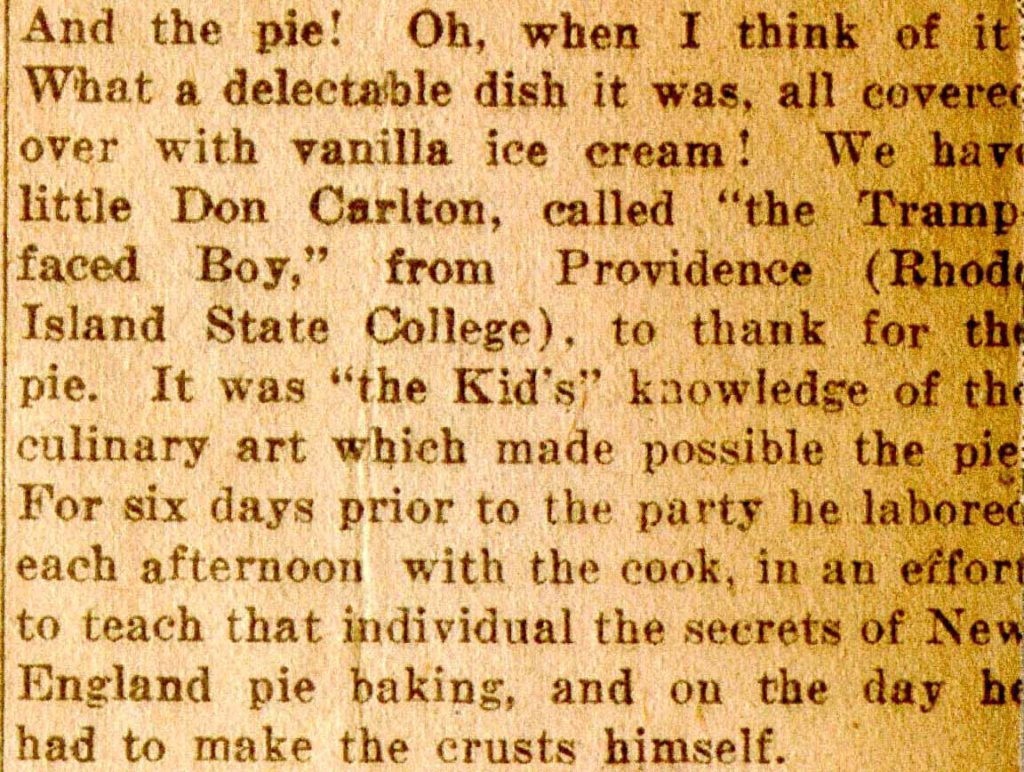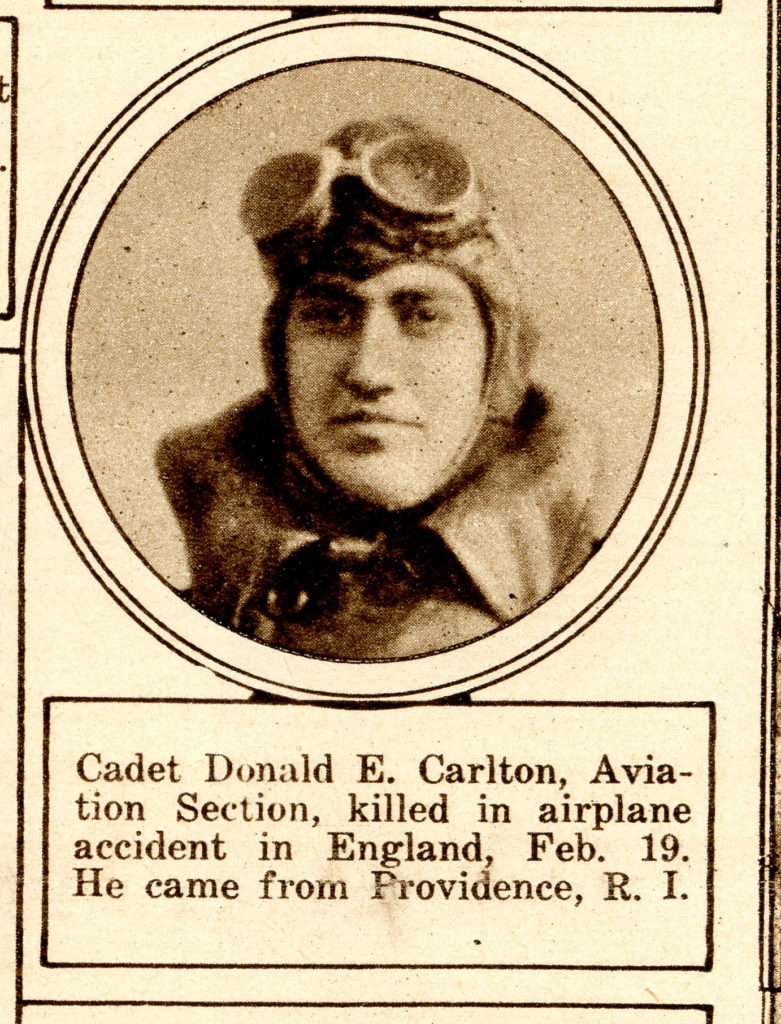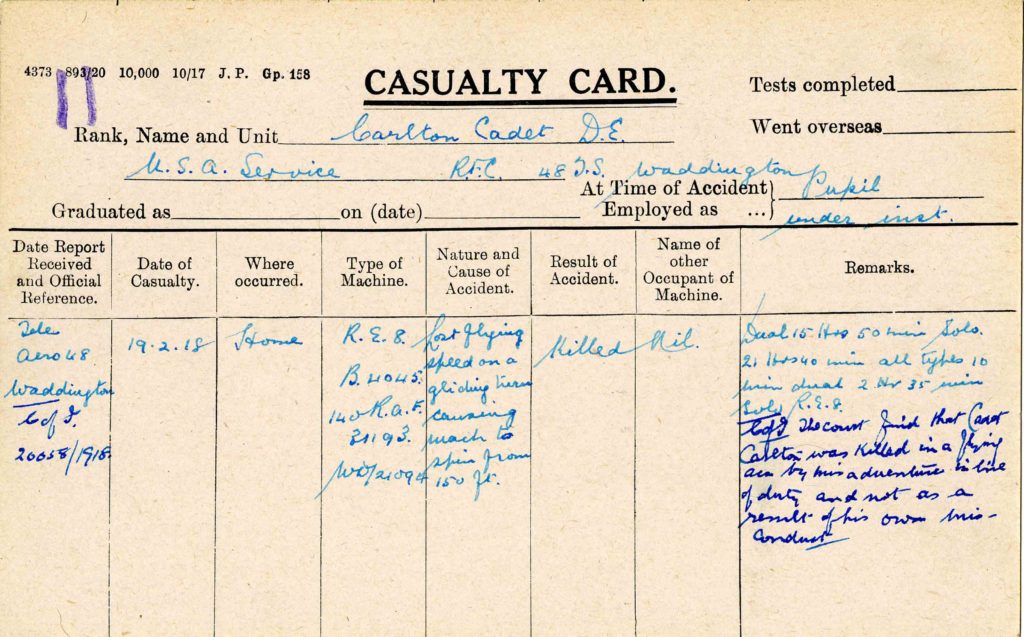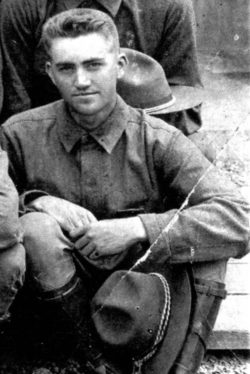(Franklin, New Hampshire, 22 November 1895 – Grantham, Lincolnshire, England, February 19, 1918).1
Carlton’s father was born in Stockton, California, but he moved back to where his roots were in New England (his own father having gone to California from Maine) and married a New Hampshire school teacher whose family had lived and farmed in that state for several generations. The family relocated to Providence, Rhode Island, not long after son Donald was born.2
Carlton attended Rhode Island State College, majoring in agriculture; he was in the class of 1918.3 When he registered for the draft at the end of May, 1917, he was at Plattsburg, N.Y., in the R.O.T.C.4 He was selected for aviation training and attended ground school at M.I.T., graduating on August 25, 1918.5
Along with about one third of his ground school classmates, Carlton chose or was chosen for flight training in Italy, and he joined the 150 men of the “Italian” or “second Oxford detachment” who sailed to England on the Carmania. They departed New York for Halifax on September 18, 1917, and departed Halifax as part of a convoy for the Atlantic crossing on September 21, 1917. When the Carmania docked at Liverpool on October 2, 1917, the detachment learned to their initial consternation that they were not to go to Italy, but to remain in England and repeat ground school at the Royal Flying Corps’s No. 2 School of Military Aeronautics at Oxford University. Like the rest of the cadets (as they were now called), Carlton soon made his peace with the change of plans, and, when not attending classes, enjoyed local sports, rowing on the Thames with Joseph Frederick Stillman, Donald Swett Poler, William Ludwig Deetjen, and Phillips Merrill Payson.6 There is an engaging photo of him from early October at Oxford with Harold Kidder Bulkley, Walter Chalaire, and Henry Bradley Frost.
From a remark in Deetjen’s diary, it appears that Carlton was among those chosen to go from Oxford to Stamford, despite presumably having had no previous flying experience.7 However, Carlton and his friend Chalaire were back at Grantham for Thanksgiving. Chalaire wrote an article about the festivities that appeared in various American newspapers. After providing a lively account of the football game, Chalaire describes Thanksgiving dinner and dessert:

“And the pie! Oh, when I think of it! What a delectable dish it was, all covered over with vanilla ice cream! We have little Don Carlton, called ‘the Tramp-faced Boy,’ from Providence (Rhode Island State College), to thank for the pie. It was ‘The Kid’s’ knowledge of the culinary art which made possible the pie. For six days prior to the party he labored each afternoon with the cook, in an effort to teach that individual the secrets of New England pie baking, and on the day he had to make the crusts himself.”8
In mid-January, according to Deetjen, he, Carlton, Julian Carr Stanley, and Chalaire, went from Stamford to Waddington; all but Deetjen were then assigned to No. 48 Training Squadron at Waddington.9 Joseph Raymond Payden, who was also at Waddington, kept a photo of Carlton with John Arnold “Jerry” Roth of the first Oxford detachment and George Orrin Middleditch of the second in flying gear.
On February 9, 1918, Carlton, along with Chalaire, who served as best man, attended the wedding in Lincoln of Annie Courtney Willimott and Sub-Lieutenant Cyril Kay, R.N.R.10 I have not discovered what connection there was between Carlton, Chalaire and the couple.

By February 19, 1918, Carlton had a fair amount of flying experience under his belt: nearly sixteen hours dual, and nearly twenty-two hours solo, including two and a half hours solo on R.E.8s.11 It was, however, not enough. On that day, Carlton and Chalaire, in separate planes, set off from Waddington heading south towards Grantham. Carlton was flying an R.E.8 (a two-seater, but without a passenger). At the end of the day on the nineteenth Deetjen wrote in his diary that “Don Carlton, poor lad, killed himself today at Spitalgate. He left here [Waddington] with Walter Chalaire, and over Spitalgate at 3000 he got into a spin, and never did get out. Chalaire saw it and thought it a large A.W. and reported so at Spitalgate. He never knew till later that it was Don. I flew over his wrecked R.E.8, and gad it was a mess. . . . I walked out and had a long chat with Don this morning. It is hard to believe that he has gone.”12 An R.A.F. incident casualty card provides this description of the “nature and cause of the accident”: “Lost flying speed on a flying turn causing mach[ine] to spin from 150 ft.” and indicates that he was flying R.E.8 B4045.13 The court of inquiry ruled a case of “misadventure.”

A funeral was held on February 22, 1918, at Newport Cemetery in Lincoln.14 Carlton was at some point reinterred in the Brookwood American Military Cemetery in Surrey.15
mrsmcq June 6, 2017
Notes
(For complete bibliographic entries, please consult the list of works and web pages cited.)
1 Date and place of birth taken from Ancestry.com, U.S., World War I Draft Registration Cards, 1917-1918, record for Donald E Carlton. The photo is a detail from a group photo of the men in his ground school class.
2 Ancestry.com, 1900 United States Federal Census, record for Donald Carlton. Information on his descent is based on documents available at Ancestry.com.
3 The Grist, vol. 21, p. 28.
4 Ancestry.com, U.S., World War I Draft Registration Cards, 1917-1918, record for Donald E Carlton.
5 “Ground School Graduations [for August 25, 1917].”
6 Deetjen, Diary, entry for April [sic, sc. October] 9, 1917.
7 Deetjen, Diary, January 18, 1918: “On the 16th Stanley, Carlton, Chalaire & I left Stamford for 44 T.S. Waddington.”
8 Chalaire, “Thanksgiving Day with the Aviators Abroad.”
9 Deetjen, Diary, January 18, 1918.
10 See “Wedding.”
11 The hours are recorded on “Carleton, D. E.,” an incident casualty card.
12 Deetjen, Diary, entry for February 19, 1918. Spitalgate (Spittlegate) was a training airfield east of Grantham.
13 See “Carlton, D. E.” Robertson, British Military Aircraft, lists B4045 as an Armstrong Whitworth F.K.8, but perhaps either the casualty card or Robertson has mistaken the number.
14 “U.S.A. Flying Officer’s Death.” Deetjen also gives a brief description of the funeral in his diary entry for February 23, 1918.
15 See “Donald E. Carlton.”

